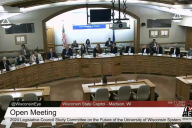You have /5 articles left.
Sign up for a free account or log in.
You know that an issue has started to resonate and find its political legs when the relevant players start competing to show they care about it.
One day after lawmakers in both houses of Congress introduced legislation that would cut the length of the Free Application for Federal Student Aid by more than half and take a variety of other steps aimed at making it easier for families to apply for federal aid, the U.S. Education Department unveiled its own effort to give students estimates of their federal financial aid awards earlier in high school and a shortcut to filing the federal financial aid form.
The department's FAFSA4caster, which will be available publicly April 1 (save the April's Fool jokes, please), will allow would-be college students or their parents to enter financial information into a tool on the department's Web site that will then give them an estimate of the federal financial aid they would qualify for and of the "expected family contribution" they should plan to make to pay for college. The information would be stored so that when they are ready to actually apply for aid, it would flow into the FAFSA form, answering about half the questions and saving them time.
By this fall, the forecaster, which is also available in Spanish, will be fleshed out (through partnerships with colleges) to give students "case examples" of how their entire financial aid packages (including state and institutional aid) might look at different types of institutions.
The tool, Education Secretary Margaret Spellings said in a telephone news conference Wednesday, "will help families and students plan for postsecondary education," and to do so "much earlier than their senior year," when most students find out how much financial aid they're eligible for. Spellings called the tool an "important first step" in simplifying the process by which millions of Americans qualify for federal student aid.
That subject has drawn increasing attention of late, as policy makers and advocates for students have looked for explanations for the comparatively low college-going rates of Americans from low-income backgrounds, as well as possible solutions. The complexity of the eight-page (including instructions), 101-question form is oft-cited as a deterrent, both because it seeks a significant amount of financial information that is both difficult to compile and intimidating. A study last year by the American Council on Education estimated that 1.5 million aid-eligible students did not fill out the FAFSA form, and the Secretary of Education's Commission on the Future of Higher Education decried what Spellings on Wednesday called the "crying need" to make it easier to apply for financial aid.
"Any new federal financial aid system should aim to replace the current federal aid form ... with a much shorter and simpler application form. The application process should be substantially streamlined by analyzing student need through a simple criterion such as family income," the commission said in its report. "Students should have information about financial aid eligibility (such as need or ability to pay) sooner and with early estimates of likely aid available as soon as the eighth grade." (Department officials also said they were testing in a small way a method for allowing students who did not have access to a computer to submit their financial information over the phone, so they could benefit from the same early warning system the department plans to provide through the Web-based FAFSA4caster.)
The initiative that Spellings announced Wednesday is just a baby step on the way to that much broader vision, but it is the most concrete step that the department has taken in that direction. It also portends a competition of sorts, coming as it does on the heels of the introduction in the House and Senate Tuesday of legislation that would go significantly further: cutting the form’s length from five pages to two, increasing Web access, allowing high school juniors to file a “Pre-FAFSA” for planning purposes and permitting the sharing of tax information between the Internal Revenue Service and the Department of Education. The last proposal seizes on a report, also issued Tuesday, in which the Institute for College Access and Success calls for enabling students to easily authorize the IRS to forward to the Education Department information about their income and assets that they have submitted on their tax forms.
Spellings acknowledged that that idea and others for going beyond the "first step" the department announced Wednesday were under discussion by department officials, and will be shared and reviewed Thursday during the summit the secretary is holding on carrying out the recommendations of her commission.









